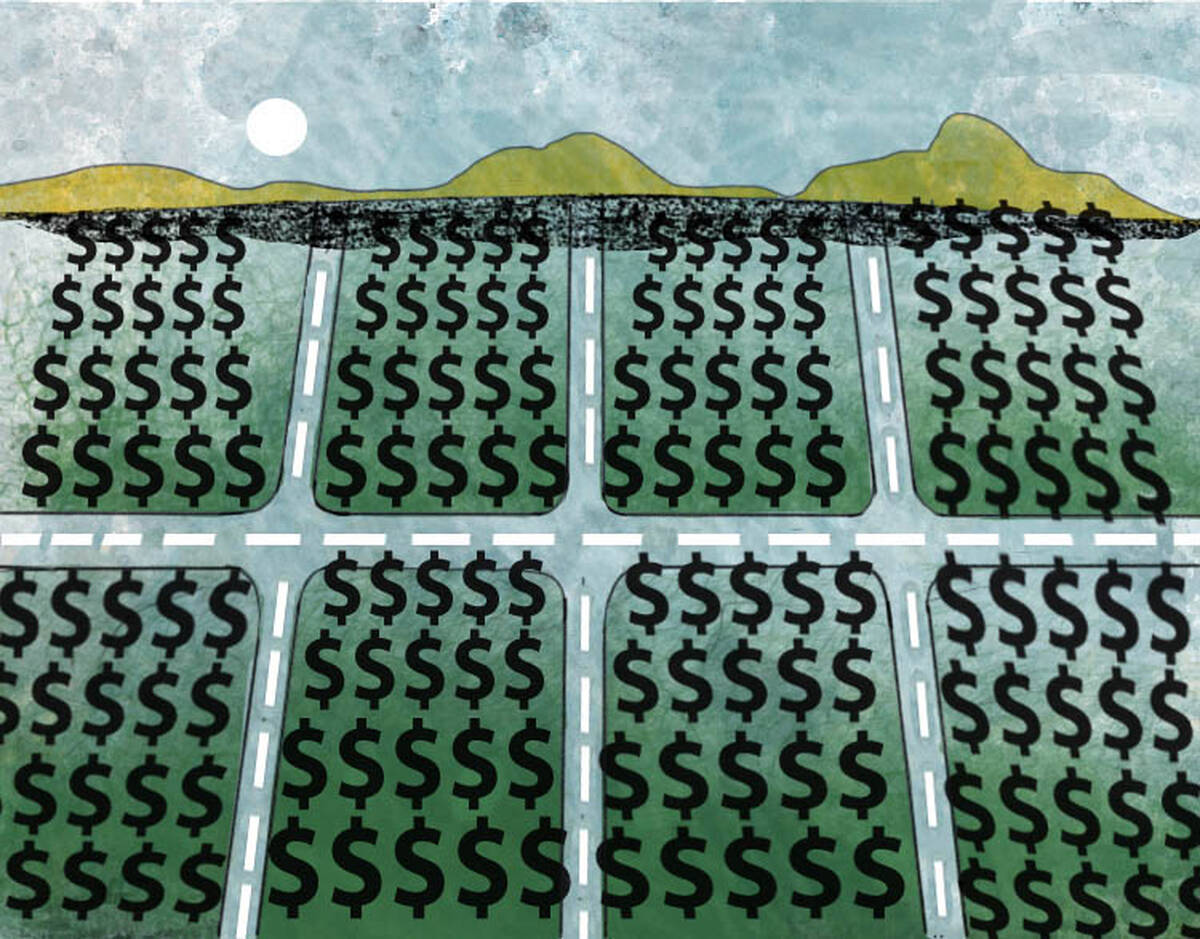Finance & Accounting Aug 3, 2015
Did Irrational Exuberance Cause Vegas’ Housing Bubble?
Why a city surrounded by open land saw prices spike.

Yevgenia Nayberg
The housing boom that began in 2000 and became a bust starting in 2007 created a mystery that confounded economists and others for years: Why did housing prices rise in cities where the economic factors should not have supported this trend?
In densely developed cities like Boston and Philadelphia, where there is little available land for new housing, the price increases made sense. They were driven by the classic economics combination of high demand and limited supply. But housing prices also rose sharply in cities like Las Vegas, where there was plenty of land for new development. Economists would expect increasing supply to balance rising demand under those conditions, keeping prices stable.
“There was this glaring puzzle,”said Charles Nathanson, assistant professor of finance at the Kellogg School. “Cities like Las Vegas and Phoenix had really big booms and busts in housing prices but also built a lot of houses. Most people thought that you could only have a housing bubble like that if it is difficult to build new houses. But there were these cities that violated the conventional wisdom pretty spectacularly.”
Economists were quick to offer solutions to the puzzle. Some attributed these inflated home prices to nationwide irrational exuberance, the concept popularized by former Federal Reserve Chairman Alan Greenspan in the mid-1990s to describe the dot-com bubble. In 2009, Harvard’s Edward Glaeser wrote in the New York Times that “the most plausible explanations of the [housing] bubble require levels of irrationality that are difficult for economists either to accept or explain.” Pointing to the case of Las Vegas specifically, Glaeser wrote that he had “underestimated the human capacity to think rosy thoughts about the value of a house.”
“If you look at their balance sheets during the housing bubble, they were basically like land hedge funds with a side business in building houses.”
But was excessive optimism about home values the sole reason behind the growth of home prices in cities like Las Vegas? Recent research by Nathanson and Eric Zwick of the University of Chicago suggests the housing-price picture is more complex. While optimism does play a role in home-price increases, it operates through different mechanisms in different cities. In Las Vegas, for example, the key factor underlying the price increases was not a rosy view of housing per se, but literally how investors viewed the land on which the houses were built. Rising land values meant skyrocketing home prices in Las Vegas and other cities.
Nathanson’s work investigated the mystery of rising home prices in non-dense cities during the boom, not only identifying land prices as a key factor but also addressing a new question that discovery raised: Why did land prices increase so much in these cities in the first place?
The Long-Term View Drove Short-Term Growth
Nathanson approached the research by creating a model of a city that included developers, residents, and a fixed amount of developable land. Then he examined how well real-life data matched the model’s behavior under specific conditions, such as a “demand shock” that rapidly elevates the inflow of residents.
A factor contributing to the mystery of housing booms in anomalous cities was that economists usually take a short-term view of the variables affecting the housing market—construction costs and restrictions on building new roads and other infrastructure, for example. So their time horizon is about five years out.
At the outset of his study, Nathanson, too, believed that such factors would explain the housing boom in “anomalous” cities like Las Vegas and Phoenix, which experienced large housing-price increases but also featured plenty of land for development. However, “it turns out that those costs just don’t seem to be a factor,” he said, based on data directly measuring growth in construction costs during the period. “Construction costs weren’t going up that much. What we found was that land prices were going up… . That was very surprising to us. It focused our research.”
Focusing on land values led the authors to broaden their thinking about the relevant time frame, and to look several decades—rather than years—down the road. For example, they found that legislation passed by Congress in 1998 established boundaries around Las Vegas that limit the land available for private development, and the city is projected to bump up against those boundaries by about 2030.
“A major turning point in the project was when we learned all these institutional details about how the land supply in Las Vegas is actually limited by the federal government,” Nathanson said. “Before we looked into that, we thought you could just build as far as you want in Clark County [where Las Vegas is located]. If you look at Google maps, that’s what you come away thinking.”
Harvard’s Glaeser had summed up this conventional view of Las Vegas in 2009, describing it as a place with “vast amounts of land” and “no significant regulation.” That view contributed to his and others’ conclusion that unwarranted optimism alone explained the home-price increases.
In reality, as suggested by Nathanson’s findings, investors anticipated long-term constraints on development (such as those promoted by legislation), and provoked a flurry of both homebuilding and land speculation. In Las Vegas, the price of land skyrocketed—from $150,000 to $650,000 per acre between 2000 and 2006—as more and more investors banked on the idea that Las Vegas would run out of developable land in the next two to three decades. The Phoenix market displayed a similar trend, as the potential for long-term development there is limited by government ownership of large tracts of land and the presence of Indian reservations on the city’s outskirts.
In other words, perceived limits to long-term growth exaggerated short-term land-price increases, driving housing prices higher in these markets.
Friction, Optimism, Pessimism
Perceived growth limits were not the only driver of land prices in anomalous cities. Nathanson and his coauthor also used their model to study the way that rental “frictions” affected prices, along with investors’ optimism or pessimism about the housing market by region.
In theory, investors who are optimistic about housing prices could buy homes and rent them out profitably. “Frictions” are factors that make that option unattractive: the headaches of being a landlord; tax disadvantages; the strong bias for owning over renting, especially among suburb dwellers, which dampens demand for rental units.
Buying land, or buying stock in companies that develop land, presents none of these drawbacks. As a result, the market for land affected housing prices in ways that the traditional model of supply and demand could not capture. Specifically, well-known frictions in the rental market made land an attractive investment, further boosting land prices and, in tandem, housing prices.
This pattern held true even though investors may have disagreed about the housing market’s future in a given region. In the anomalous markets like Phoenix, investors who were pessimistic about the future of the housing market avoided land speculation, while optimistic investors bought land or shares of land-development firms, contributing to the housing boom. Housing prices in densely developed cities, in the meantime, rose sharply but hewed more closely to the traditional model of supply and demand, for two main reasons: there was minimal speculation in land values to drive prices higher, and housing prices reflected the aggregate beliefs of both pessimists and optimists. Based on these factors, housing prices in some anomalous cities soared even higher than in their fully developed coastal counterparts.
What Have We Learned?
The housing market is a key driver of the broader economy, as demonstrated by painful lessons from the financial crisis of 2008. So it is important to learn from housing booms and busts. One clear policy implication of Nathanson’s research is that long-range thinking by investors will dramatically affect short-term prices, even if their perceptions are flawed. “Even the threat of supply regulation can have an impact on housing prices in the short run,” he said. “Even if a city isn’t currently making it hard to get permits and is just creating an environment where people are afraid that it will in the long run—that can drive up house prices today and create an environment where a housing bubble is possible.”
Another takeaway is the dramatic role that homebuilders can play in the boom-and-bust cycle. As part of their study, the researchers collected data on the eight largest public homebuilders in the U.S.
“If you look at their balance sheets during the housing bubble, they were basically like land hedge funds with a side business in building houses,” Nathanson said. “They were rapidly increasing the amount of land on their balance sheet. And their stock prices went up a lot—and fell a lot.”
Between 2001 and 2010, the firms’ stock prices increased 430 percent—but then fell 74 percent. The homebuilders had tripled their landholdings between 2001 and 2005, and “landholdings rose more than nine times relative to home sales.” As the researchers write, “The majority of the losses borne by homebuilders arose from losses on the land portfolios they accumulated from 2001 to 2005.” The finding suggests the need for a more cautious approach on the part of homebuilders and their investors.
Financial advisors generally encourage investors to take the long view. But in the recent boom and bust, ironically, homebuilders and investors with a long-term perspective built a house of cards—and contributed to the deep economic recession that followed.
“Arrested Development: Theory and Evidence of Supply-Side Speculation in the Housing Market,” Working paper.



